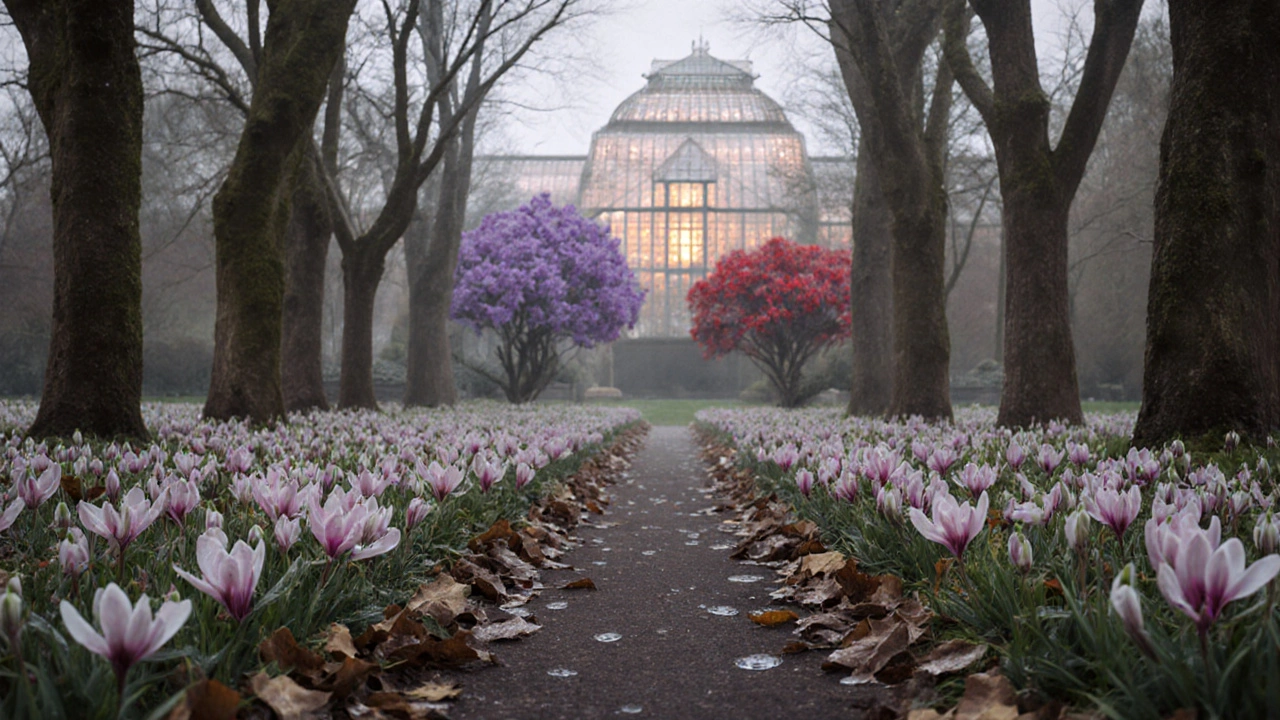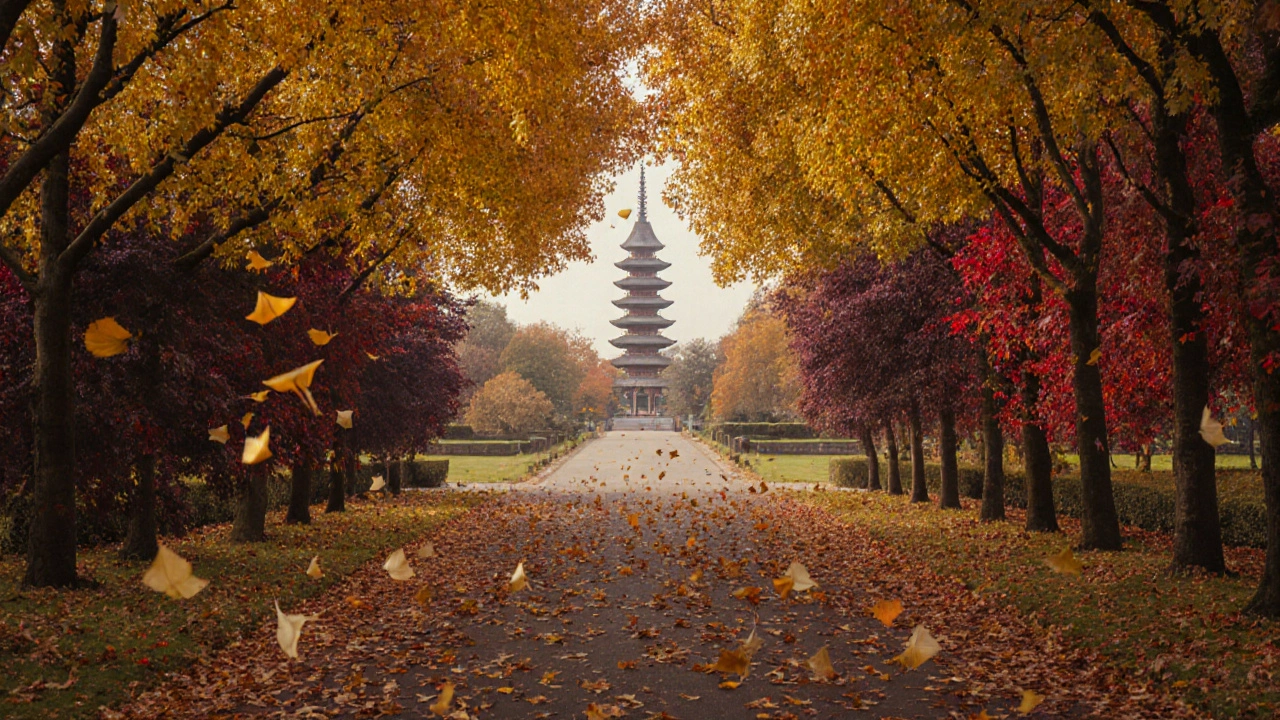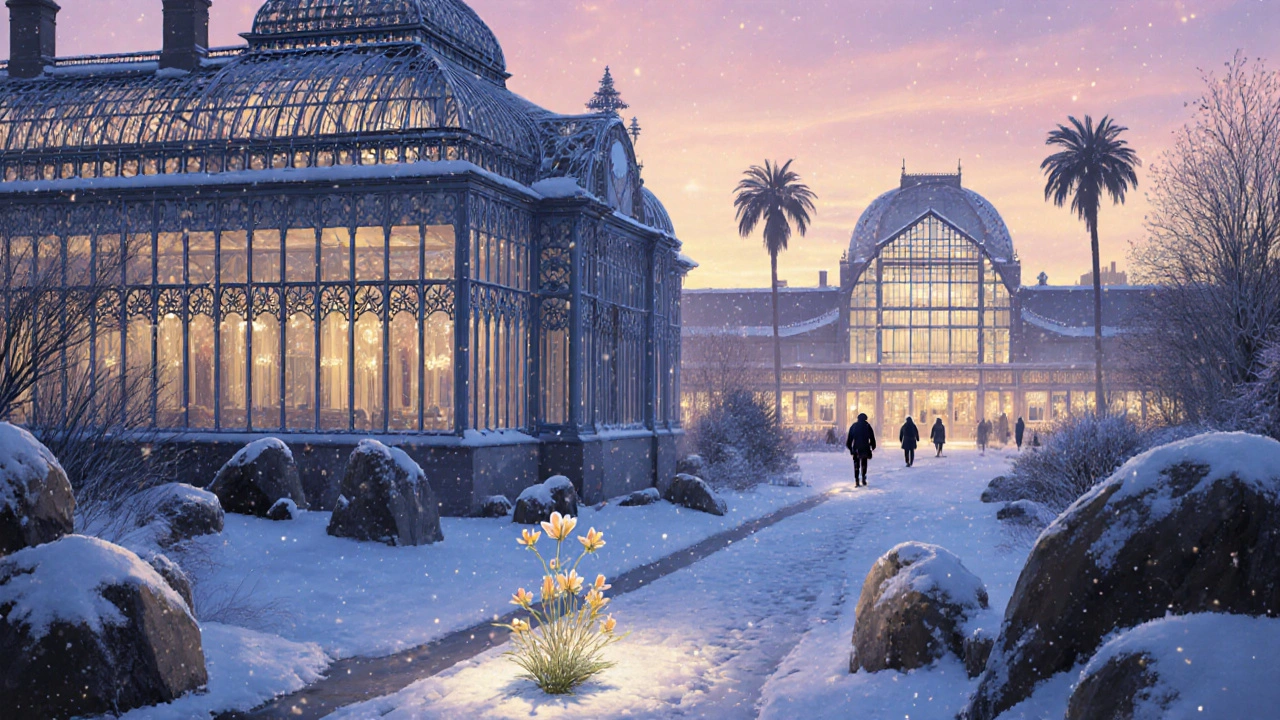
When you walk through the gates of Kew Gardens, you’re not just stepping into a park-you’re entering one of the most important living plant collections on Earth. Located in southwest London, the Royal Botanic Gardens, Kew, holds more than 50,000 living plants and over 7 million preserved specimens in its herbarium. It’s not just beautiful; it’s a scientific powerhouse, a conservation lifeline, and a quiet escape from the city’s rush. And the best part? It changes completely with the seasons.
Spring: The Awakening of Color
Spring at Kew is a riot of color that starts as early as February. The snowdrops push through the damp soil in the Woodland Garden, delicate white bells nodding under the bare branches. By March, the magnolias burst into bloom-pink, white, and purple flowers so large they look like they’ve been painted on the trees. The famous Rhododendron Dell explodes into life by April, with hundreds of varieties blooming in layered waves of violet, crimson, and peach.
Don’t miss the Orchid House, where tropical blooms mimic rainforest conditions. In spring, rare species like the Ghost Orchid and the Monkey Face Orchid are in peak display. These aren’t just pretty flowers-they’re part of a global effort to save endangered plants. Kew’s Millennium Seed Bank stores seeds from over 40,000 plant species, many of them from habitats under threat.
Spring is also when the Japanese Maple Grove turns into a living watercolor. The young leaves unfurl in shades of burnt orange and soft red, reflected perfectly in the still ponds below. Locals know to come on a weekday morning-before the tour groups arrive-to walk the paths without crowds and hear only birdsong and rustling leaves.
Summer: Green Canopies and Open Air
Summer turns Kew into a lush, humid paradise. The Temperate House, the largest surviving Victorian glasshouse in the world, feels like stepping into a jungle. Inside, you’ll find towering cycads from Madagascar, ancient ferns from New Zealand, and the rare Wollemi Pine-one of the oldest tree species on Earth, thought extinct until 1994.
Outside, the Rose Garden is in full glory. Over 2,500 rose bushes bloom in every shade imaginable, from pure white to deep burgundy. The scent alone is worth the visit. Many of these roses are heritage varieties, saved from disappearing by Kew’s conservation team. You’ll find the ‘Duchess of Portland’, bred in 1863, still blooming strong.
The Palm House, with its curving iron ribs and glass panels, is another summer highlight. Inside, humidity clings to your skin as you walk past banana plants taller than a person and giant water lilies with leaves strong enough to hold a child. In July, the water lilies open their flowers at dawn, revealing bright yellow centers that fade to pink by afternoon.
Summer evenings bring live music in the gardens. On warm nights, families spread blankets on the lawn near the Great Pagoda while jazz or classical music plays. It’s a London tradition that feels timeless.
Autumn: Gold, Crimson, and Quiet Reflection
Autumn at Kew is quieter but no less stunning. The trees don’t just change color-they put on a performance. The Liquidamber trees turn fiery red, the ginkgoes glow like molten gold, and the maples burn orange and crimson. The Arboretum, with over 14,000 trees, becomes a living palette. Walk the Long Walk in late October, and you’ll crunch through a carpet of fallen leaves that smell like earth and spice.
Don’t miss the Fagus sylvatica ‘Purpurea’-a purple beech tree that holds its deep burgundy leaves longer than most. It’s one of the most photographed trees in the garden. In November, the last of the berries appear: hawthorn, rowan, and holly. These aren’t just decorations-they’re food for birds migrating south.
Autumn is also when Kew’s fungal diversity comes into focus. The Fungarium, the world’s largest collection of dried fungi, holds over 1.25 million specimens. In the wild, you’ll spot mushrooms sprouting in the damp corners of the garden-some harmless, others deadly. Kew’s mycologists use these finds to study climate change impacts and new medicines.

Winter: Stillness and Structure
Winter might seem like a quiet time at Kew, but it’s when the garden’s true architecture shines. Without leaves, the shapes of trees and hedges become clear. The Great Pagoda, built in 1762, stands out against the gray sky, its 10 stories crowned with golden dragons. The Temperate House’s iron framework looks like a cathedral of steel and glass.
Even in frost, life persists. The Alpine House shelters plants from mountain regions that bloom only in cold. The Himalayan Primrose, which flowers in late winter, is one of the rarest in the collection. You’ll find it tucked behind rocks, its pale yellow blooms glowing like tiny lanterns.
Christmas at Kew is magical. The Light Trail returns each December, with over 50,000 LED lights illuminating the trees, pathways, and glasshouses. It’s not just a display-it’s an art installation that tells the story of plant life through color and movement. Families come back year after year. Kids point at glowing orchids and whisper, “That’s a real plant?”
Why Kew Matters Beyond Beauty
Kew isn’t just a tourist spot. It’s a global research center. Scientists here have helped identify over 2,000 new plant species since 2000. They’ve developed drought-resistant crops for Africa, mapped the spread of invasive species, and worked with indigenous communities to protect traditional plant knowledge.
The garden also runs the UK’s National Plant Collection program, safeguarding rare and heritage varieties. One example: the ‘Kew Red’ apple, bred in the 1930s and nearly lost until Kew revived it from a single surviving tree in Kent.
Every year, over 1.3 million visitors come through the gates. But only a fraction know that Kew’s work extends to rainforests in Peru, deserts in Namibia, and coral reefs in the Pacific-all connected through the plants they protect.

What to See and Do
- Don’t miss the Treetop Walkway-a 18-meter-high suspension bridge that lets you walk among the canopy of mature trees. It’s the best spot for photos in autumn.
- Visit the Shirley Sherwood Gallery of Botanical Art-home to the world’s finest collection of plant paintings. The details are so precise you can count the veins on a leaf.
- Take a guided tour-free with entry, offered daily. The botanists know where the rarest blooms hide.
- Bring a sketchbook-many artists come to draw the orchids, ferns, and mosses. You don’t need to be skilled; just sit quietly and watch.
Plan Your Visit
Kew Gardens is open daily from 10 a.m. to 6 p.m. (last entry at 5 p.m.). Tickets cost £21 for adults, £10.50 for children, and are free for members. You can buy tickets online to skip the queues. The nearest station is Kew Gardens on the District Line, just a five-minute walk from the main entrance.
There’s no need to rush. Even if you only have two hours, you can still see the Palm House, the Rose Garden, and the Japanese Garden. But if you have a full day, wander. Get lost in the Bamboo Grove. Sit by the pond and watch the koi. Let the quiet settle into your bones.
Kew Gardens isn’t just a place you visit. It’s a place that stays with you.
Is Kew Gardens free to enter?
No, Kew Gardens is not free. Entry costs £21 for adults and £10.50 for children under 17. Members of the Royal Botanic Gardens, Kew, get free access year-round. You can also get discounted tickets if you book online in advance. Some special events, like the Christmas Light Trail, require separate tickets.
What’s the best time of year to visit Kew Gardens?
Spring (March to May) is the most popular time for flowers, especially rhododendrons and orchids. Autumn (October to November) offers stunning leaf color and fewer crowds. Summer (June to August) is ideal for the Palm and Temperate Houses, but it’s busiest. Winter is quiet and peaceful, with unique architectural beauty and the Christmas Light Trail. Each season has its own magic.
Can you eat at Kew Gardens?
Yes, there are several options. The Kew Café serves hot meals, sandwiches, and cakes. The Palm House Café offers lighter snacks and drinks with views of the glasshouse. For a more formal experience, The Orangery serves afternoon tea with garden views. You’re also welcome to bring your own picnic and eat on the lawns near the Great Pagoda.
Is Kew Gardens wheelchair accessible?
Yes, Kew Gardens is largely wheelchair accessible. Most paths are paved and flat, and wheelchairs and mobility scooters are available to hire for free. The Palm House, Temperate House, and Treetop Walkway have lifts. The Great Pagoda is not accessible due to its historic staircase, but there’s a virtual tour available at the visitor center.
How long does it take to explore Kew Gardens fully?
You can see the highlights in two to three hours, but if you want to explore every glasshouse, garden, and trail, plan for a full day. Many visitors spend five or six hours wandering slowly, reading plaques, sketching plants, or just sitting under a tree. The gardens cover 300 acres-there’s a lot to discover.